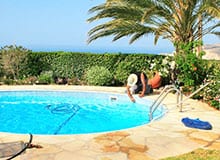Ugh, why does the pool look so dingy? It could be because of the swimming pool plaster. How to protect the swimming pool plaster is something the swimming pool service contractors from SwimRight Pool Service & Repair in Scottsdale, AZ talk with their customers about.
The swimming pool tile is visible and if it’s not looking its best the rest of the pool — no matter how beautiful — just might not have that luster that it should. In addition to its aesthetic appeal, the pool plaster is a crucial protective layer between the pool water and the pool shell. The plaster finish is not only critical because if its looks, but because of the task it performs.
How to protect the swimming pool plaster
No matter how well you care for your pool, at some point, the plaster will need special attention to address the look and the function of it.
Some of the issues that arise with pool plaster include:
- Stains
- Erosion
- Etching
- Discoloration
- Hairline cracks
What causes some of these issues?
- Pool water in which the water chemistry is not properly balanced. One of the main causes of deterioration of the pool plaster is that the water chemistry is not in balance. If the chemicals are not balanced it can lead to any of the issues above (other than the hairline cracks).
- Organic matter that is not cleaned off the bottom of the pool. If you live in an area of the country where leaves fall from the trees and if you don’t clean those leaves up, they can discolor the pool tile. Organic matter can also get blown into the swimming pool during Arizona’s monsoon season. Skim the pool frequently and don’t let debris fall to the bottom. Using a pool cover will also protect the pool plaster.
- Shifting ground (whether from earthquakes or shifting of the dirt behind the pool itself can lead to hairline cracks in the plaster.
To protect the plaster in your pool, keep the water chemistry balanced, clean out organic matter and don’t let hairline cracks go unaddressed.


